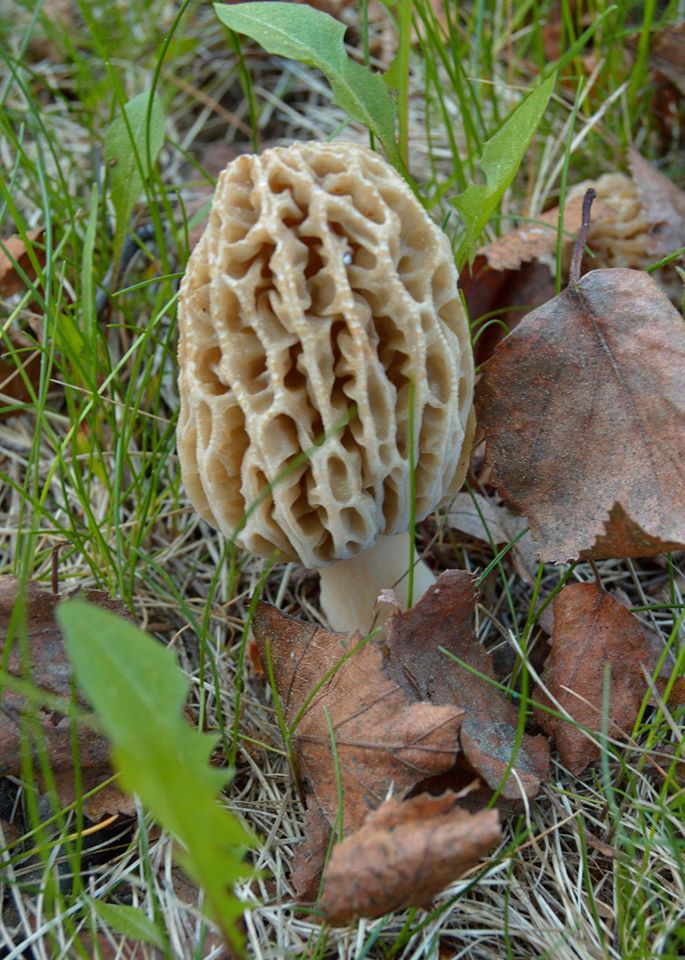
Nestled among the leaves, under fallen logs, and climbing up out of the recently scorched forest floor, the mushrooms have already begun erupting. The most popular of these are the Morel. Morels are a common mushroom found in spring and early summer throughout the United States. They are one of the most prized of the forest fungi, and their taste — which has been described as “nutty” drives people to great lengths to acquire them. So treasured are they that they command prices as high as $15 a pound! This fact makes mushroom pickers very protective of their favorite spots, and many of them search for years for the best place to find their little gold mines.
Morels first appear in spring, and they begin to blossom best when the soil temperature finally works its way into the lower 40s. A good sign to look for is the blooming of wild strawberries and salmonberries, but any day after Mother’s day when a good rain shower is followed by a couple of warm, sunny days can provide excellent hunting!
The biggest concern anytime you start hunting these fun little guys (see what I did there?) is proper identification of which mushrooms you have found. Take your time and educate yourself.
Morels belong to the genus Morchella. Mycologists don’t know how many actual species of morels exist, but there are two main species for the mushroom hunter- black and yellow. The morels can vary in shape and size. Two key identifying features distinguish them from false morels: The lower edge of the cap is fused to the stalk, and true morel caps and stems are hollow when sliced lengthwise.
If you find lots of ‘morels’ near melting snow, they’re usually not true morels. Sometimes called the snow-bank false morel, the Gyromitra gigas is not recommended food. It contains traces of MMH, monomethylhydrazine, a self-oxidizing chemical used in rocket fuel.
Morels are the most popular, but far from the only species found here in Kootenai Country Montana! When foraging for mushrooms, the common puffball, also known as Lycoperdon perlatum, is found throughout Montana. These mushrooms are often found in groups and have a white color that changes as the mushroom ages, a thick stem and a bulbous top. The surface of the common puffball is covered by tiny spikes. While edible, take care when picking this mushroom — the destroying angel and stinkhorn mushroom varieties have a similar look but are not safe for human consumption.

Oyster mushrooms grow directly on dead wood and contain very little to no stem. The cream to white-gray hued caps are broad and flat, typically 2-inches to 8-inches in width. This oyster, common in Montana, resembles the color of oyster meat, and some people feel as if this oyster emits the scent of oysters, which is how the oyster got its name. While you should be relatively certain the mushrooms you choose are oyster mushrooms, no poisonous mushrooms resembling this variety exist in Montana.
While traipsing through the woods in Montana, you may run across a mushroom with a classic mushroom look — broad, beige-tan cap and a stem that ranges in color from off-white to olive green. Rather than gills on the underside of the mushroom cap, though, this mushroom has pores. Be cautious when picking the king bolete. No lookalikes grow in Montana that can kill you, but some mushrooms with a similar look can cause nausea and vomiting.
Websites such as Western Montana Mycological Association can provide a great deal of additional information before you start hunting. The U.S. Forest Service does not require a permit for hunters who gather under 5-gallons of mushrooms, and free permits are available for those who gather 5-20 gallons. Commercial permits are not being issued this year. Kootenai Country Montana is a great place to explore, and for those who love to hunt mushrooms, it is a veritable treasure trove.